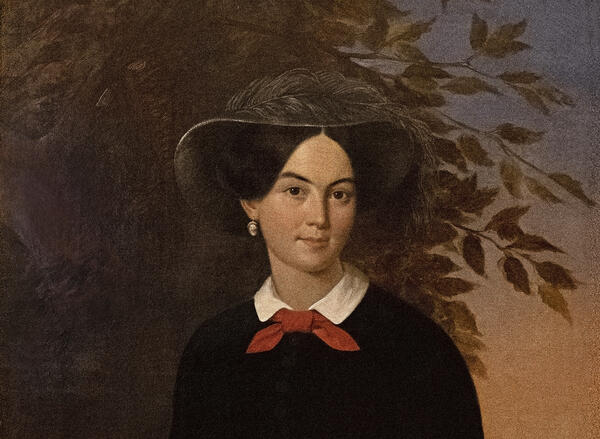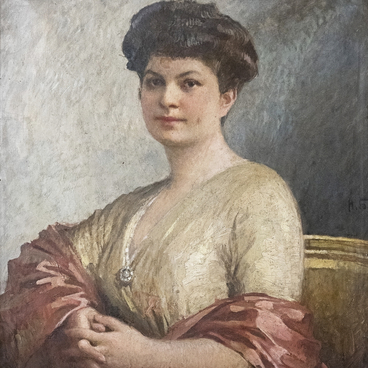‘Portrait of K. K. Dolgolova’ by Eugene Pluchart was donated to the museum from a private collection in 1991. The portrait was kept as a family heirloom, but there remained no information about the model.
Pluchart painted ‘Portrait of Dolgolova’ in 1849, at the end of the Romanticism era. During this period, the artists were mainly interested in the inner world of a person. Romantic portrait painters sought to depict their models in an unusual, extraordinary environment, to portray them at a special moment in life, in order to highlight their feelings and thoughts.
The portrait depicts a young girl in a riding habit. She stands on the balcony, against the backdrop of rural scenery; at the edge of a field behind her shoulder is a group of villagers. The model’s thoughtful and calm face attracts the main attention. In this way, Pluchart emphasized the inner maturity of Mrs. Dolgolova and her quiet charm.
The artist meticulously paints the details that are important for a romantic portrait — the feathers on a woman’s hat, the suit with gold ornaments, and the thin whip in her hands. The depiction of a bright summer day and the young tree branches behind the model’s back make the composition of the painting harmonious and complete.
Eugene Pluchart was born in 1809, in St. Petersburg, into the family of a French typographer Alexander Pluchart. In 1828–1832, he studied in Munich and then returned to Russia.
The artist painted a number of murals in St. Isaac’s Cathedral, among which the critics praised the composition ‘God appears to Moses in the Burning Bush’. In 1836, Pluchart received the ‘appointed academician’ title for the painting ‘Odalisque’, and in 1839 — the academician title of the Imperial Academy of Arts in the category of portrait painting for the portrait of the musician Karol Lipinski. In the 1850s, he opened a photographic studio in St. Petersburg.
Pluchart became famous for his magnificent portraits, which were very popular in the 1830s–1840s. His models were mainly representatives of the St. Petersburg nobility. He painted many celebrities, including the Spanish-French singer Pauline Viardot and the sister of Alexander Pushkin, Olga Pavlishcheva.
Pluchart painted ‘Portrait of Dolgolova’ in 1849, at the end of the Romanticism era. During this period, the artists were mainly interested in the inner world of a person. Romantic portrait painters sought to depict their models in an unusual, extraordinary environment, to portray them at a special moment in life, in order to highlight their feelings and thoughts.
The portrait depicts a young girl in a riding habit. She stands on the balcony, against the backdrop of rural scenery; at the edge of a field behind her shoulder is a group of villagers. The model’s thoughtful and calm face attracts the main attention. In this way, Pluchart emphasized the inner maturity of Mrs. Dolgolova and her quiet charm.
The artist meticulously paints the details that are important for a romantic portrait — the feathers on a woman’s hat, the suit with gold ornaments, and the thin whip in her hands. The depiction of a bright summer day and the young tree branches behind the model’s back make the composition of the painting harmonious and complete.
Eugene Pluchart was born in 1809, in St. Petersburg, into the family of a French typographer Alexander Pluchart. In 1828–1832, he studied in Munich and then returned to Russia.
The artist painted a number of murals in St. Isaac’s Cathedral, among which the critics praised the composition ‘God appears to Moses in the Burning Bush’. In 1836, Pluchart received the ‘appointed academician’ title for the painting ‘Odalisque’, and in 1839 — the academician title of the Imperial Academy of Arts in the category of portrait painting for the portrait of the musician Karol Lipinski. In the 1850s, he opened a photographic studio in St. Petersburg.
Pluchart became famous for his magnificent portraits, which were very popular in the 1830s–1840s. His models were mainly representatives of the St. Petersburg nobility. He painted many celebrities, including the Spanish-French singer Pauline Viardot and the sister of Alexander Pushkin, Olga Pavlishcheva.




